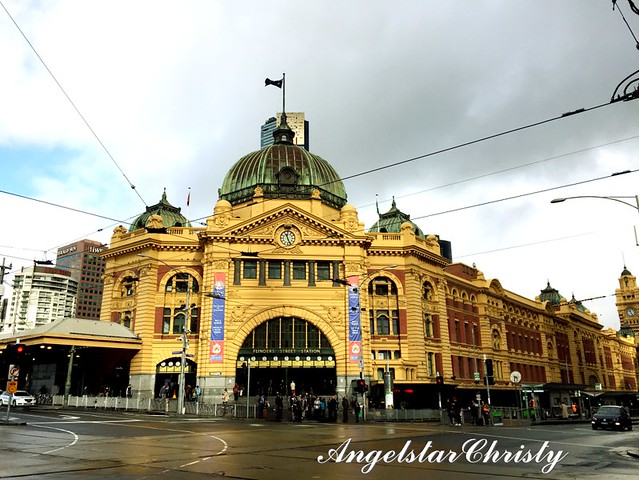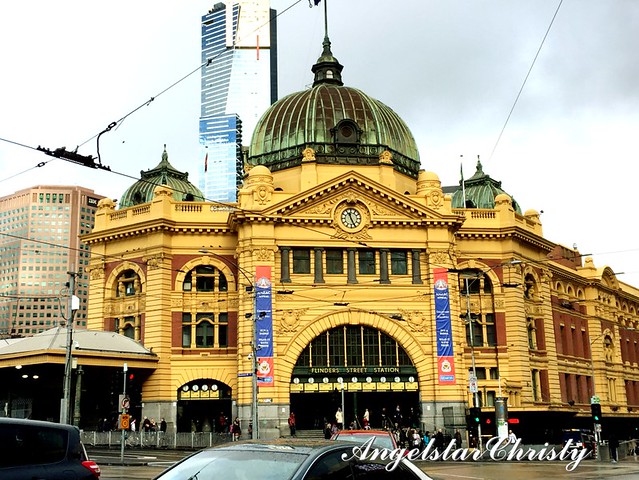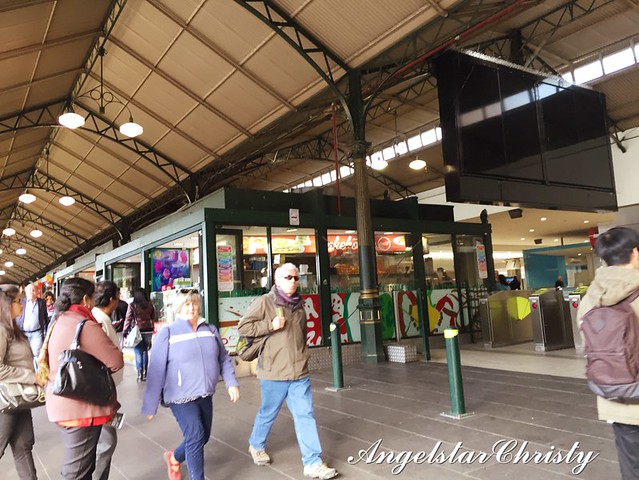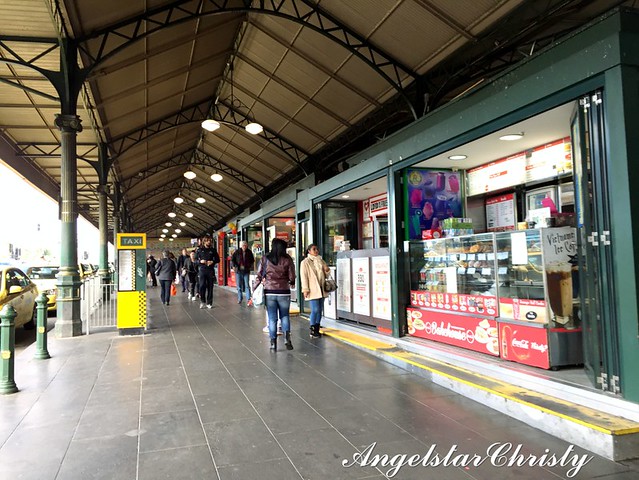Melbourne city's landmarks will not be complete without the iconic and recognizable bright yellow building of the Flinders Street Station.

Standing right in the middle of the city; at the corner of the Flinders and Swanston Street, the sight of this large complex, with its characteristic green dome perched atop the building, decorated with a gigantic clock, tower; further lined with a row of clocks displaying the scheduled departure times of the train on each respective line, is definitely not to be missed as one takes a walk or even a ride in the city.
This historic and cultural building is further swanked by the unique arched or diagonally positioned entrance, symbolically taking its place proudly on most of the city's postcards.

It is a charming sight indeed, as though it is just a snapshot taken out of a photo album.

Trams run across the front of the stations, among the busy flow of cars in both directions on the main street and flanked by the crowds of people traversing up and down the streets lined with bridges, skyscrapers and even trees on the side of the river flowing through the city.
This is the common sight surrounding Melbourne's busiest railway station with an average of recorded 92,600 daily entries based on a weekday tracking basis.
Flinders Street railway Station has more than meets the eye; with its long trail of history dating back to its early beginnings as the new station back in the 1900s, in succession to the first ever railway station, the preceding Melbourne Terminus on that same site on Flinders Street.
Beginning its operations in the year 1854, Melbourne Terminus was then the first railway station in Australia, with a single platform of only 30 meters long, which saw the launch of the first steam train in the country on its opening day.
Located beside the Fish Market building on the south west corner end of both prominent Swanston and Flinders Street, the single platform station quickly expanded within two decades with the upcoming demand and additional platform in 1877, followed by overhead bridges, telegraph station(1879) and signal boxes in 1883 made up the improved layout of the railway station.
The station continues to grow in its operations and in the 1890s, the third platform was then added to accommodate the growth in the transportation demands.
There were two other ad hoc railway stations in the city centre; Spencer Street and Princes Bridge, which both commenced operations in the year 1859, serving the routes to the different parts of the city.
Spencer Street functioned to serve the west part of the city, and was isolated from the eastern region, until the year 1879 where it saw the establishment of a ground level railway connecting it to the Flinders Street; which was also quickly replaced by the Flinders Street Viaduct in the year 1889.
Princes Bridge was even more short-lived in its service; with the station being closed in the year 1865 when there was a railway line built to connect both Flinders Street and Swanston Street - where Princes Bridge was originally disconnected from and with the existence of this line, there was no longer purpose for the station, although it was reopened much later on in 1879 again and then integrated into the Flinders Street track from the 1909 which is currently the site of the Federation Square; right across the present Flinders Street Station.
The need for a centralized railway station came through in 1882, despite having many designs which were fulfilling the requirements since the 1880s.
The design of the new railway station called for a design competition in the year 1899, in which there were 17 entries received.
Today's Flinders Street Station was based on the first prize winning design; by both railway employees, James Fawcett and HPC Ashworth of Fawcett and Ashworth, which included a large dome and a clock tower in their titled piece of the Green Light, styled after a French Renaissance theme.
A year after the selection of the design, construction works on the new railway station finally begun in the year 1900. The dome was erected in the year 1906 and the entire station saw its completion and official and historic launch in the year 1910.
The establishment of the Flinders Street railway Station marks the first railway station in an Australian city and the first electric train took off from this station to Essendon in 1919.
Flinders Street railway Station became the world's busiest passenger station in the late 1920s.



One of the walls in Flinders Street Station

Standing on its site, today still sees the hectic operations and running schedules of the railway station which never ceases in serving the transportation needs of the Melbourne city population.
The beauty and history of the building has even earned her a place as one of the heritage buildings in the Victorian Heritage Register, making this one of the most prestigious landmarks and the pride of the Melbournians.
There is really no way one could miss or even mistake the sight of this memorable building and even I kept running into it, every time I walk around the city.
(Well, maybe I do delibrately want to run into this station to catch a glimpse of most of the daily actions. Its charms have truly captivated me and had me enthralled with its history and architecture).

**Special Note:
Both are notable idioms commonly used among the local Melbournians in reference to this city icon.
"I'll meet you under the clocks" refer to the row of clocks neatly lined above the main entrance and shows the time-table scheduled departure times of each individual train line.
"I'll meet you on the steps" refer to the main staircase; in its wide and grand welcoming manner fronting the entrance to the station.




0 comments